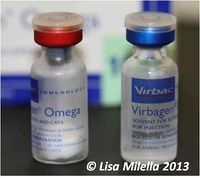Difference between revisions of "Other Medication for Oral Disease"
| (5 intermediate revisions by 2 users not shown) | |||
| Line 1: | Line 1: | ||
| + | {{OpenPagesTop}} | ||
==Steroids== | ==Steroids== | ||
| − | Systemic [[steroids]] produce | + | Systemic [[steroids]] produce excellent temporary improvement in oral diseases such as chronic gingivostomatitis but have '''significant side effects''' and lose their efficacy with repeated use. They should '''never be used as a first line treatment''' and only be used in certain cases, following biopsy and initial first line treatments. Steroids also artificially improve the disease state making an accurate assessment very difficult. Steroids should be used as a last resort. |
==Interferon== | ==Interferon== | ||
[[File:Interferon bottle.jpg|right|200px|thumb|Interferon <small>''© Lisa Milella 2013''</small>]] | [[File:Interferon bottle.jpg|right|200px|thumb|Interferon <small>''© Lisa Milella 2013''</small>]] | ||
| − | Interferons are [[cytokines]] that have '''anti-viral, antiproliferative and immunomodulatory effects'''. Virbagen®Omega is a recombinant omega interferon of feline origin (rFeIFN- ω) produced by genetic engineering. Virbagen®Omega is a Type 1 Interferon, closely related to | + | Interferons are [[cytokines]] that have '''anti-viral, antiproliferative and immunomodulatory effects'''. Virbagen®Omega is a recombinant omega interferon of feline origin (rFeIFN- ω) produced by genetic engineering. Virbagen®Omega is a Type 1 Interferon, closely related to human alpha and beta interferons. [[Interferons]] bind to specific receptors on the plasma membrane of other cells. The binding activates a complex transcriptional cascade, leading to the up-regulation of more than 20 cellular genes, producing an interferon-activated cell. IFN-induced proteins are numerous and each protein confers a new property to the cell. This may be antiviral, immune modulating or antiproliferative. The antiviral effect of an interferon-activated cell results from the induction of specific proteins which inhibit viral multiplication and viral protein synthesis. The antiproliferative effect of an interferon-activated cell results in regulation of the genes controlling cell division which can lead to the inhibition of cell proliferation and an anti-tumoral effect.<br><br> |
| − | The benefits of using Interferon in feline chronic gingivostomatitis (FCGS) have yet to be properly documented and studied but consensus is that there are significant benefits. Interferon is recommended as an adjunct to the other treatments. Initially | + | The benefits of using Interferon in feline chronic gingivostomatitis (FCGS) have yet to be properly documented and studied but consensus in practice is that there are significant benefits. Interferon is recommended as an adjunct to the other treatments. Initially systemic administration followed by daily oral dosage was used. However, the current recommendation is to use intralesional injections at the time of main treatment, followed by oral dosage. |
| + | |||
| + | |||
| + | {{Lisa Milella written | ||
| + | |date = 13 August 2014}} | ||
| + | |||
| + | {{Waltham}} | ||
| + | |||
| + | {{OpenPages}} | ||
[[Category:Dental and Oral Medication]] | [[Category:Dental and Oral Medication]] | ||
| − | [[Category: | + | [[Category:Waltham reviewed]] |
Latest revision as of 14:11, 2 November 2014
Steroids
Systemic steroids produce excellent temporary improvement in oral diseases such as chronic gingivostomatitis but have significant side effects and lose their efficacy with repeated use. They should never be used as a first line treatment and only be used in certain cases, following biopsy and initial first line treatments. Steroids also artificially improve the disease state making an accurate assessment very difficult. Steroids should be used as a last resort.
Interferon
Interferons are cytokines that have anti-viral, antiproliferative and immunomodulatory effects. Virbagen®Omega is a recombinant omega interferon of feline origin (rFeIFN- ω) produced by genetic engineering. Virbagen®Omega is a Type 1 Interferon, closely related to human alpha and beta interferons. Interferons bind to specific receptors on the plasma membrane of other cells. The binding activates a complex transcriptional cascade, leading to the up-regulation of more than 20 cellular genes, producing an interferon-activated cell. IFN-induced proteins are numerous and each protein confers a new property to the cell. This may be antiviral, immune modulating or antiproliferative. The antiviral effect of an interferon-activated cell results from the induction of specific proteins which inhibit viral multiplication and viral protein synthesis. The antiproliferative effect of an interferon-activated cell results in regulation of the genes controlling cell division which can lead to the inhibition of cell proliferation and an anti-tumoral effect.
The benefits of using Interferon in feline chronic gingivostomatitis (FCGS) have yet to be properly documented and studied but consensus in practice is that there are significant benefits. Interferon is recommended as an adjunct to the other treatments. Initially systemic administration followed by daily oral dosage was used. However, the current recommendation is to use intralesional injections at the time of main treatment, followed by oral dosage.
| This article was written by Lisa Milella BVSc DipEVDC MRCVS. Date reviewed: 13 August 2014 |
| Endorsed by WALTHAM®, a leading authority in companion animal nutrition and wellbeing for over 50 years and the science institute for Mars Petcare. |
Error in widget FBRecommend: unable to write file /var/www/wikivet.net/extensions/Widgets/compiled_templates/wrt673f74a48ce8c5_56775988 Error in widget google+: unable to write file /var/www/wikivet.net/extensions/Widgets/compiled_templates/wrt673f74a49b95f8_15528872 Error in widget TwitterTweet: unable to write file /var/www/wikivet.net/extensions/Widgets/compiled_templates/wrt673f74a4a300b4_10306686
|
| WikiVet® Introduction - Help WikiVet - Report a Problem |
